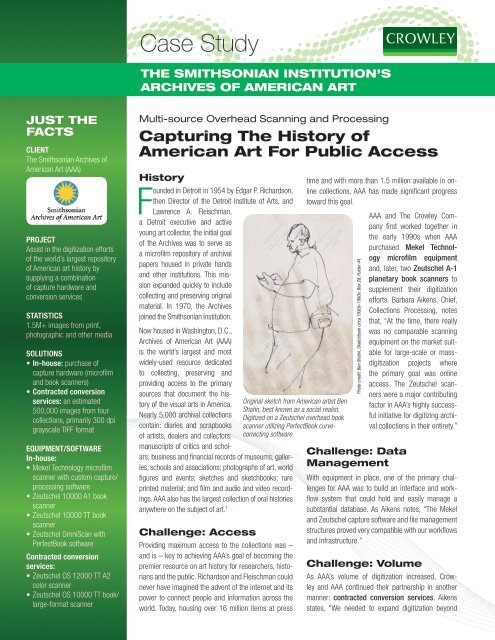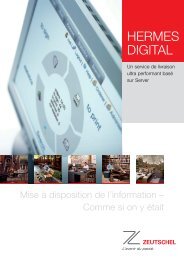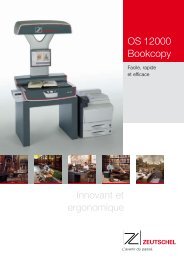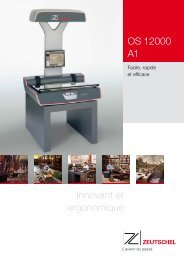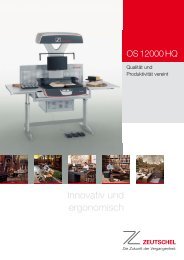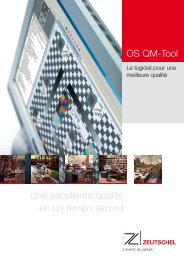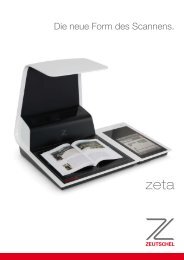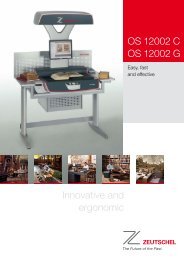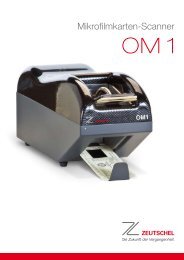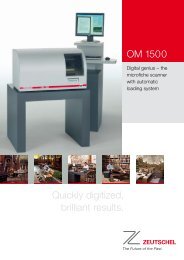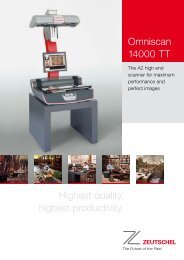Capturing The History of American Art For Public - Zeutschel
Capturing The History of American Art For Public - Zeutschel
Capturing The History of American Art For Public - Zeutschel
You also want an ePaper? Increase the reach of your titles
YUMPU automatically turns print PDFs into web optimized ePapers that Google loves.
JUST THE<br />
FACTS<br />
CLIENT<br />
<strong>The</strong> Smithsonian Archives <strong>of</strong><br />
<strong>American</strong> <strong>Art</strong> (AAA)<br />
PROJECT<br />
Assist in the digitization efforts<br />
<strong>of</strong> the world’s largest repository<br />
<strong>of</strong> <strong>American</strong> art history by<br />
supplying a combination<br />
<strong>of</strong> capture hardware and<br />
conversion services<br />
STATISTICS<br />
1.5M+ images from print,<br />
photographic and other media<br />
SOLUTIONS<br />
• In-house: purchase <strong>of</strong><br />
capture hardware (micr<strong>of</strong>ilm<br />
and book scanners)<br />
• Contracted conversion<br />
services: an estimated<br />
500,000 images from four<br />
collections, primarily 300 dpi<br />
grayscale TIFF format<br />
EQUIPMENT/SOFTWARE<br />
In-house:<br />
• Mekel Technology micr<strong>of</strong>ilm<br />
scanner with custom capture/<br />
processing s<strong>of</strong>tware<br />
• <strong>Zeutschel</strong> 10000 A1 book<br />
scanner<br />
• <strong>Zeutschel</strong> 10000 TT book<br />
scanner<br />
• <strong>Zeutschel</strong> OmniScan with<br />
PerfectBook s<strong>of</strong>tware<br />
Contracted conversion<br />
services:<br />
• <strong>Zeutschel</strong> OS 12000 TT A2<br />
color scanner<br />
• <strong>Zeutschel</strong> OS 10000 TT book/<br />
large-format scanner<br />
Case Study<br />
THE SMITHSONIAN INSTITUTION’S<br />
ARCHIVES OF AMERICAN ART<br />
Multi-source Overhead Scanning and Processing<br />
<strong>Capturing</strong> <strong>The</strong> <strong>History</strong> <strong>of</strong><br />
<strong>American</strong> <strong>Art</strong> <strong>For</strong> <strong>Public</strong> Access<br />
<strong>History</strong><br />
Founded in Detroit in 1954 by Edgar P. Richardson,<br />
then Director <strong>of</strong> the Detroit Institute <strong>of</strong> <strong>Art</strong>s, and<br />
Lawrence A. Fleischman,<br />
a Detroit executive and active<br />
young art collector, the initial goal<br />
<strong>of</strong> the Archives was to serve as<br />
a micr<strong>of</strong>ilm repository <strong>of</strong> archival<br />
papers housed in private hands<br />
and other institutions. This mission<br />
expanded quickly to include<br />
collecting and preserving original<br />
material. In 1970, the Archives<br />
joined the Smithsonian Institution.<br />
Now housed in Washington, D.C.,<br />
Archives <strong>of</strong> <strong>American</strong> <strong>Art</strong> (AAA)<br />
is the world’s largest and most<br />
widely-used resource dedicated<br />
to collecting, preserving and<br />
providing access to the primary<br />
sources that document the history<br />
<strong>of</strong> the visual arts in America.<br />
Nearly 5,000 archival collections<br />
contain: diaries and scrapbooks<br />
<strong>of</strong> artists, dealers and collectors;<br />
manuscripts <strong>of</strong> critics and schol-<br />
ars; business and financial records <strong>of</strong> museums, galleries,<br />
schools and associations; photographs <strong>of</strong> art, world<br />
figures and events; sketches and sketchbooks; rare<br />
printed material; and film and audio and video recordings.<br />
AAA also has the largest collection <strong>of</strong> oral histories<br />
anywhere on the subject <strong>of</strong> art. 1<br />
Challenge: Access<br />
Original sketch from <strong>American</strong> artist Ben<br />
Shahn, best known as a social realist.<br />
Digitized on a <strong>Zeutschel</strong> overhead book<br />
scanner utilizing PerfectBook curvecorrecting<br />
s<strong>of</strong>tware.<br />
Providing maximum access to the collections was –<br />
and is – key to achieving AAA’s goal <strong>of</strong> becoming the<br />
premier resource on art history for researchers, historians<br />
and the public. Richardson and Fleischman could<br />
never have imagined the advent <strong>of</strong> the internet and its<br />
power to connect people and information across the<br />
world. Today, housing over 16 million items at press<br />
time and with more than 1.5 million available in online<br />
collections, AAA has made significant progress<br />
toward this goal.<br />
Photo credit: Ben Shahn, Sketchbook circa 1930s-1960s. Box 28, Folder 44.<br />
Challenge: Data<br />
Management<br />
AAA and <strong>The</strong> Crowley Company<br />
first worked together in<br />
the early 1990s when AAA<br />
purchased Mekel Technology<br />
micr<strong>of</strong>ilm equipment<br />
and, later, two <strong>Zeutschel</strong> A-1<br />
planetary book scanners to<br />
supplement their digitization<br />
efforts. Barbara Aikens, Chief,<br />
Collections Processing, notes<br />
that, “At the time, there really<br />
was no comparable scanning<br />
equipment on the market suitable<br />
for large-scale or massdigitization<br />
projects where<br />
the primary goal was online<br />
access. <strong>The</strong> <strong>Zeutschel</strong> scanners<br />
were a major contributing<br />
factor in AAA’s highly successful<br />
initiative for digitizing archival<br />
collections in their entirety.”<br />
With equipment in place, one <strong>of</strong> the primary challenges<br />
for AAA was to build an interface and workflow<br />
system that could hold and easily manage a<br />
substantial database. As Aikens notes, “<strong>The</strong> Mekel<br />
and <strong>Zeutschel</strong> capture s<strong>of</strong>tware and file management<br />
structures proved very compatible with our workflows<br />
and infrastructure.”<br />
Challenge: Volume<br />
As AAA’s volume <strong>of</strong> digitization increased, Crowley<br />
and AAA continued their partnership in another<br />
manner: contracted conversion services. Aikens<br />
states, “We needed to expand digitization beyond
our in-house capabilities; particularly for very large collections. <strong>For</strong> our<br />
large-scale efforts, the combination <strong>of</strong> in-house scanning and contracted<br />
services gave us the highest productivity at the best price. Crowley<br />
was a logical partner due to their close proximity to the nation’s capital<br />
and the fact that they <strong>of</strong>fered competitive pricing.”<br />
In this digital<br />
image <strong>of</strong> a French<br />
magazine clipping<br />
from the papers<br />
<strong>of</strong> Henry and Rose<br />
Pearlman, collectors<br />
<strong>of</strong> Impressionist and<br />
post-Impressionist<br />
paintings, a black<br />
border is left to<br />
assure the client that<br />
all data has been<br />
captured and also<br />
allows the scanner<br />
to easily determine<br />
image boundaries.<br />
She continues, “I feel that Crowley understands that our large-scale<br />
digitization initiative is about volume and access. <strong>The</strong> goal <strong>of</strong> this project<br />
was – and is – about getting a high quantity <strong>of</strong> good quality digital<br />
images in a timely fashion so that we can make our resources more<br />
widely available and accessible on a global level.”<br />
Sample Collections<br />
Recent AAA Crowley Imaging conversion services projects include:<br />
• An estimated 130,000 images from the Carnegie Institute Museum<br />
<strong>of</strong> <strong>Art</strong> collection<br />
• An estimated 130,000 images from the Ben Shahn collection<br />
• Approximately 6,500 images from the Pearlman collection<br />
• More than 320,000 images from the Jacques Seligmann & Co. collection,<br />
one <strong>of</strong> AAA’s largest fully-digitized collections available online<br />
Images have been scanned from multiple media including: letters;<br />
manuscripts; bound materials; photographs; fragile/onion skin<br />
materials; and some original sketches. Primarily using <strong>Zeutschel</strong><br />
12000 scanners (a newer generation <strong>of</strong> those originally purchased by<br />
AAA), Crowley Imaging staff were able to produce high-quality images<br />
regardless <strong>of</strong> the condition <strong>of</strong> the original material.<br />
1 Archives <strong>of</strong> <strong>American</strong> <strong>Art</strong><br />
Photo credit: Pearlman Papers, <strong>Art</strong>ists’ Files, Various, <strong>Art</strong>icles and Clippings, 1930-1952.<br />
Box 4, Folder 1<br />
<strong>The</strong> Results<br />
Through capture hardware and conversion services, <strong>The</strong> Crowley Company<br />
played a major role in assisting AAA reach its 2011 milestone<br />
<strong>of</strong> having 1.5 million digital images available online. AAA’s digitization<br />
initiative is now part <strong>of</strong> its long term mission, which has changed very<br />
little since the early vision <strong>of</strong> Richardson and Fleishman: to share and<br />
make available hidden archival treasures regarding <strong>American</strong> art.<br />
Pat Crowley, company vice president, notes, “We appreciate the initiative<br />
<strong>of</strong> the Archives in managing their collections and have enjoyed being an<br />
integral part in their strategy.”<br />
Ultimately, it is the end user who benefits from this partnership. As one<br />
example, the availability <strong>of</strong> the Jacques Seligmann & Co. archives has<br />
satisfied the needs <strong>of</strong> users across the world conducting World War II<br />
era art provenance research. <strong>The</strong> online collection has been referenced<br />
in several international-level symposia.<br />
About <strong>The</strong> Crowley Company<br />
Similar Crowley scanning projects in scope and interest include those for<br />
the Harvard Divinity School, the U.S. Holocaust Memorial Museum, LIFE<br />
Magazine and many others. Incorporated in 1981, <strong>The</strong> Crowley Company<br />
is a leading digital and analog film technologies company headquartered<br />
in Frederick, Md. with manufacturing divisions (Mekel, Wicks and Wilson,<br />
Extek and HF Processor brands) in California and the U.K. With over<br />
100 employees, <strong>The</strong> Crowley Company provides an extensive number<br />
<strong>of</strong> digital document and film conversion services to the publishing,<br />
commercial, government and archive sectors and also manufactures,<br />
sells, and services high-speed micr<strong>of</strong>ilm, micr<strong>of</strong>iche and aperture card<br />
scanners, micr<strong>of</strong>ilm duplicators, film processors and micrographics<br />
equipment.<br />
<strong>For</strong> more information:<br />
www.thecrowleycompany.com<br />
www.aaa.si.edu<br />
“Crowley understands that our projects are all<br />
about access and our desire to ‘get it out there’<br />
for users across the globe.”<br />
– Barbara Aikens, Chief <strong>of</strong> Collections Processing<br />
5111 Pegasus Court, Suite M, Frederick, Maryland 21704 USA • 240.215.0224<br />
www.thecrowleycompany.com • studies@thecrowleycompany.com


